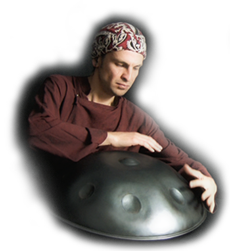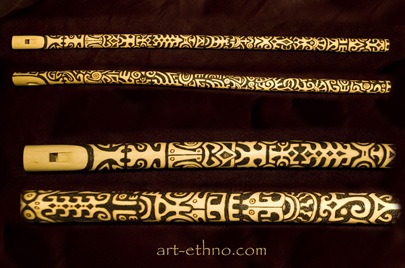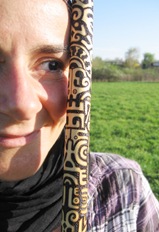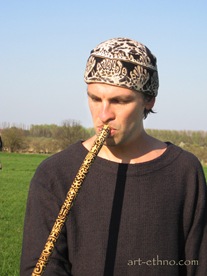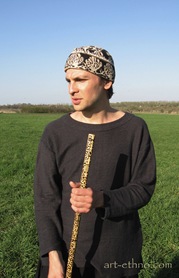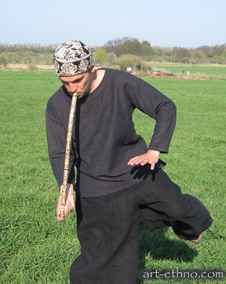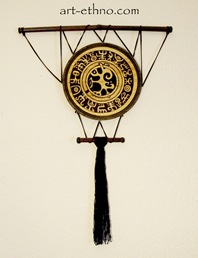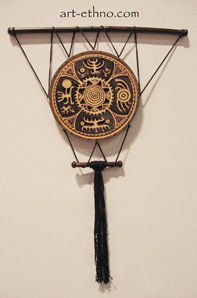This is traditional Tuvan song in non-traditional interpretation, arrangement made by us spontaneously. We had 1 hour of time and we was just celebrating our occasional meeting. In fact this is the combination of ancient tuvan folklore, contemporary fusion jazz, some middle eastern music and kuzhebarian rhythms:)
Raphael De Cock - vocals, throat singing (khoomei, kargyraa, sygyt), uilleann pipes
Dmitry Gorelik - guitar
Nadishana - hybrid kaval, dan moi
Recording made in KKStudio, Gliwice, Poland
Big thanks to Krzysztof Kobyli??ski and Michal from KKStudio
- Material - elder tree
- D key (C key available as well)
- made by Max Brumberg,
- Pyrography - Julia Surba
- Presentation - Nadishana
Price from 110 EUR (depending on artwork amount). Made by request. Available at our ethnic store now.
Flute decoration consists of fertility symbols and symbols connected with the ritual of Kuzhebar people called Shuol Khymat.
Shuol Khymat were usually celebrated twice a year ??? at spring (Ashuol Khymat) and at autumn (Yshuol Khymat). Ancient Kuzhebar people considered the sun as a source of the great power, which can be used in various ways. Their method of solar energy utilization is very similar to the description of photosynthesis process. We think it???s connected with their belief that human and plant worlds are not separated, more than humans are partly plants. It might be said that kuzhebar people had a peculiar knowledge about what we call now photosynthesis and vitamin D fixation.
Most relevant translation of ???Shuol Khymat??? term is Photosynthesis Dance (capturing-solar-energy dance)
Unfortunately the complete ritual is lost, but we had used some elements of it which are still extant. Normally the ritual had to take place in a very sunny day. It was accompanied by playing on overtone flute and by special movements. Ancient kuzhebar people believed that flute sounds in combination with special dance help to capture the solar energy in a most efficient way.
- Материал - бузина
- Тональность - Ре
- Флейта работы Макса Брумберга,
- Пиродизайн - Юлия Сурба
- Демонстрация - Владисвар Надишана
Цена флейты - от 110 евро (в зависимости от количества декоративной работы). Изготавливается на заказ
Дизайн флейты составляют перетекающие друг в друга символы плодородия и символы относящиеся к древнекужебарскому ритуалу шуол кхымат.
Шуол кхымат проводился обычно два раза в год: весной (ашуол кхымат) и осенью (йшуол кхымат) и был тесно связан с солнечной активностью. Древние кужебарцы считали Солнце источником великой силы, которую оно ниспосылает в дар всем живым существам, и которую можно и нужно использовать. Их метод использования солнечной энергии по описанию схож с описанием процесса фотосинтеза у растений. Видимо это связано с тем, что древние кужебарцы не отделяли растительный мир от мира человека. Человек воспринимался ими как часть растительного мира, а растения, как часть человеческого. Можно сказать, что древние кужебарцы имели свое понимание процессов, которые сегодня называются фотосинтез и усваивание витамина D.
Наиболее адекватный перевод термина шуол кхымат - танец фотосинтеза (захвата солнечной энергии).
К сожалению полная форма ритуала утрачена. Для презентации обертоновой флейты нами были использованы его некоторые сохранившиеся элементы. Ритуал обязательно проводился ясным погожим днем, сопровождался музыкальным наигрышем на обертоновой флейте и определенными телодвижениями. Считалось, что звуки флейты в сочетании с танцем позволяют наиболее полно захватывать свет для его последующего преобразования. Изъясняясь современным научным языком, можно сказать, что в результате проведения шуол кхымата происходило захватывание квантов света для дальнейших процессов поглощения, превращения и использования содержащейся в них энергии в различных эндэргонических реакциях.
Это новая модель язычкового мелодического барабана, который можно купить в нашем этно-магазине. На каждый язычок был добавлен октавный обертон, что ощутимо улучшило звучание инструмента.
This is the new improved model of 1Tone drum. In this version the second layer of octave overtones has been added to each tongue which makes it different from other metal tongue drums drums.
http://shop.nadishana.com/1tone
you can buy this instrument here.
Gianni has been playing the didjeridoo for thirteen years and he has followed the project Ab-Origine for at least three years, working on the body, the breath and the rhythm. The thread conductor of this work and what has impassioned him, they have been the questions: Where is the rhythm born? What is the origin of this breath? Why to a heartbeat another follows of it? What's it hidden in the abyss of the silence? This strange fruit that is matured and that the pleasure he has to make you taste it, is ???Ab-Origine???. A strange, powerful and mysterious fruit. A work on the languages rare in it kind. But above all a work on the man, on his emotions and on their meaning.
To such end, this work uses more some collaboration musicians: the afro pecussionist Cico Rossi, the virtuoso multi instrumentalist Vladiswar Nadishana (jaws harp and harmonic flute), the teacher of Gregorian singing Federica Di Leonardo, the theremin player Valerio Can?©, the saxophonist Ivan Valentini, the electronic sound effects and drum machine of Enrico Marani and the cumbus and cavaquinho guitars of Nico Canzoniero. Obviously, the didjeridoo and the shakuhachi flute played by Gianni!!
Древние кужебарские легенды часто повествуют о храбрых путешественниках, которые отваживались путешествовать по разным туннелям реальности. Так они встречались с другими мирами, отличными от знакомого нам.
Иногда из путешествий им удавалось принести с собой объекты других миров, а иногда они пытались изобразить места в которых бывали. Такие объекты и изображения использовались затем путешественниками для того, чтобы снова попасть в понравившийся им мир.
Здесь можно заглянуть в Три Магических Окна, реконструированных Юлией Сурба, которые ведут в три разных мира.


